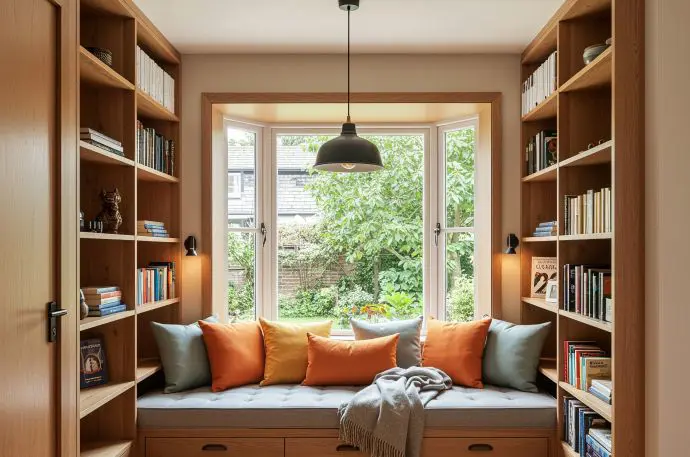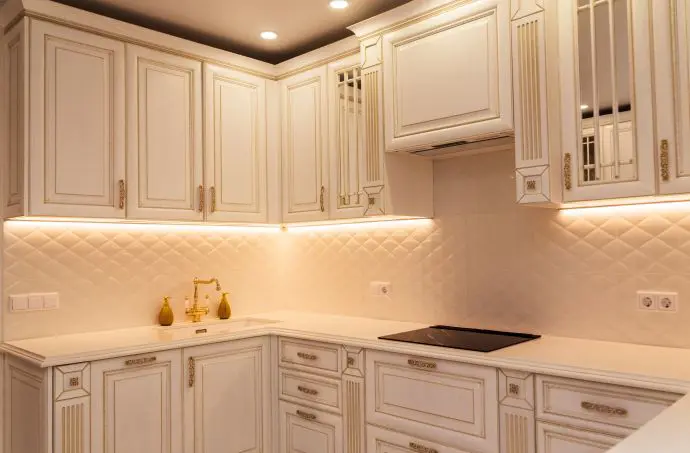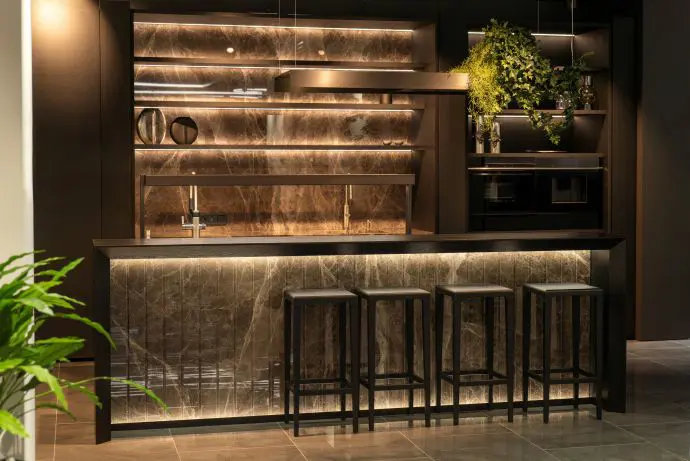June 05, 2025
When you plan for it from the start, lighting can become part of the architecture of your home. It can highlight the beauty of the wood, create a sense of depth, or simply make a space feel more inviting. Whether it’s a softly lit reading nook or a glowing display case, built-in lighting makes the details stand out.
In this blog, we’ll explore how custom lighting integration can make or break your custom millwork designs.
The Benefits of Built-In Lighting for Interiors

"Life is all about seating and lighting."
- Graydon Carter
Ambiance and Visual Impact
Lighting has the power to shift a room’s entire mood. Built-in LED strips or puck lights can emphasize the grain of a beautiful walnut shelf, highlight architectural features, or cast a soft glow that turns functional cabinetry into a work of art.
One advantage of integrating lighting into millwork is precision. Unlike surface-mounted fixtures, the result is clean, concealed, and visually refined.
Always consider color temperature early on. Warmer light (2700K–3000K) complements rich woods and traditional spaces, while cooler temperatures (3500K–4000K) pair well with modern, minimalist designs.
Functional Task Lighting
Lighting might impact the functionality of how you live in your space. Under-cabinet lights make prep work easier in a kitchen. Bookshelf lighting makes evening reading cozier. Illuminated bathroom vanities offer clarity without harsh overhead glare.
With today’s low-profile lighting technology, you can add effective illumination right where you need it, without bulky fixtures or exposed cords. Dimmer switches and smart lighting controls are well worth the investment. They allow for layered lighting and adaptability throughout the day.
Popular Lighting Applications in Custom Millwork

Integrated lighting can be functional and stylish. Under-cabinet lighting, for example, is unobtrusive but effective, adding a modern element to kitchen spaces.
Under-Cabinet and Shelf Lighting
A classic for good reason. Integrated strip lighting beneath upper kitchen cabinets or floating shelves offers both functionality and style. Recessed channels or routed grooves can house LEDs that disappear when off, but glow beautifully when needed.
In display shelving, placing lights toward the front edge helps illuminate objects more evenly. Back-placed lights can create a dramatic halo effect. Choose high-quality LED tape with a high Color Rendering Index (CRI 90+). It ensures true-to-life color, which is especially important in kitchens or art displays.
Backlighting and Accent Panels
Backlighting can create depth, especially when used with textured or translucent materials. Consider incorporating it behind slatted wood screens, laser-cut panels, or decorative wall installations to add richness and warmth.
We often design backlit millwork for headboards, fireplace surrounds, or entryways, where soft illumination creates a welcoming statement. Frosted diffusers help eliminate hotspots and ensure even lighting. Ask your millwork expert about integrated channels that accommodate both LED strips and diffusers.
Integrated Lighting in Display Cases and Niches
For collectors or design enthusiasts, nothing spotlights a beloved object quite like built-in illumination. To showcase art, crystal, vintage books, or heirlooms, use display lighting to draw the eye and enhance the experience.
Our team builds lighting into display cases with hidden wiring channels and custom-fabricated housings. You’ll never see the source, only the effect.
Puck lights offer focused light, while linear LEDs are better for even coverage. The choice depends on the items you’re showcasing.
Electrical Planning and Installation Tips

Pro tip: leave electrical work to the experts!
Planning for Wiring During Fabrication
Lighting integration must be considered during the design and fabrication stages of your millwork. Routing for wiring, making space for transformers or drivers, and coordinating access points all require careful foresight.
At Joseph A. Interiors, we collaborate closely with you to map out wire paths, avoid structural interference, and ensure that the final installation is both beautiful and safe. You might want to decide early on where your light switches, dimmers, or smart controls will be located. The more integrated your plan, the cleaner the final result.
Working with Lighting Designers and Contractors
Lighting is part art, part science. We always recommend partnering with an experienced lighting designer, especially for high-end or multi-zone systems. Ask your contractor if they’ve worked on lighting-integrated millwork before. Seamless coordination is key to avoiding costly on-site modifications later.
Together with your contractor and electrician, we coordinate every element, from fixture selection to power supply to install sequencing.
Custom millwork is already a statement of craftsmanship. When paired with thoughtful lighting, it becomes immersive, functional, and emotionally resonant. If you’re planning a luxury renovation, boutique retail space, or simply want to elevate your interiors with detail-driven design, we’d love to talk. Let’s bring your vision to life!



